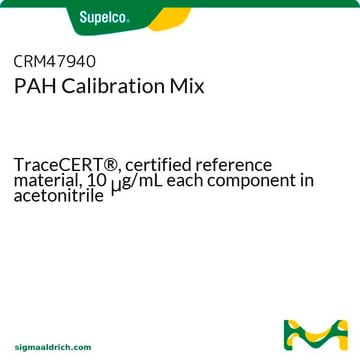48535
Fluoranthene
analytical standard
Synonyme(s) :
Benzo[j,k]fluorène
About This Item
Produits recommandés
Qualité
analytical standard
CofA (certificat d'analyse)
current certificate can be downloaded
Conditionnement
ampule of 5000 mg
Technique(s)
HPLC: suitable
gas chromatography (GC): suitable
Point d'ébullition
384 °C (lit.)
Pf
105-110 °C (lit.)
Application(s)
environmental
Format
neat
Température de stockage
2-30°C
Chaîne SMILES
c1ccc-2c(c1)-c3cccc4cccc-2c34
InChI
1S/C16H10/c1-2-8-13-12(7-1)14-9-3-5-11-6-4-10-15(13)16(11)14/h1-10H
Clé InChI
GVEPBJHOBDJJJI-UHFFFAOYSA-N
Vous recherchez des produits similaires ? Visite Guide de comparaison des produits
Catégories apparentées
Description générale
Application
Mention d'avertissement
Warning
Mentions de danger
Conseils de prudence
Classification des risques
Acute Tox. 4 Oral - Aquatic Acute 1 - Aquatic Chronic 1
Code de la classe de stockage
11 - Combustible Solids
Classe de danger pour l'eau (WGK)
WGK 2
Point d'éclair (°F)
388.4 °F - closed cup
Point d'éclair (°C)
198.0 °C - closed cup
Équipement de protection individuelle
dust mask type N95 (US), Eyeshields, Gloves
Choose from one of the most recent versions:
Déjà en possession de ce produit ?
Retrouvez la documentation relative aux produits que vous avez récemment achetés dans la Bibliothèque de documents.
Les clients ont également consulté
Articles
Highly accurate HPLC-FLD method for evaluating 15 PAHs in olive oil using Ascentis® Express PAH HPLC column and SPE cleanup, following GB 5009.265-2021.
Notre équipe de scientifiques dispose d'une expérience dans tous les secteurs de la recherche, notamment en sciences de la vie, science des matériaux, synthèse chimique, chromatographie, analyse et dans de nombreux autres domaines..
Contacter notre Service technique![Benzo[b]fluoranthene analytical standard](/deepweb/assets/sigmaaldrich/product/structures/175/744/6fa5fca2-b6ec-47b6-ab7a-fe895843f226/640/6fa5fca2-b6ec-47b6-ab7a-fe895843f226.png)



![Benzo[ghi]perylène analytical standard](/deepweb/assets/sigmaaldrich/product/structures/154/740/c50ff1be-dfb4-4159-a98c-9cecf9206ad3/640/c50ff1be-dfb4-4159-a98c-9cecf9206ad3.png)
![Benzo[k]fluoranthene for fluorescence, ≥99%](/deepweb/assets/sigmaaldrich/product/structures/277/320/3e615f9f-3887-40f6-b176-bc1eb9b4832c/640/3e615f9f-3887-40f6-b176-bc1eb9b4832c.png)





